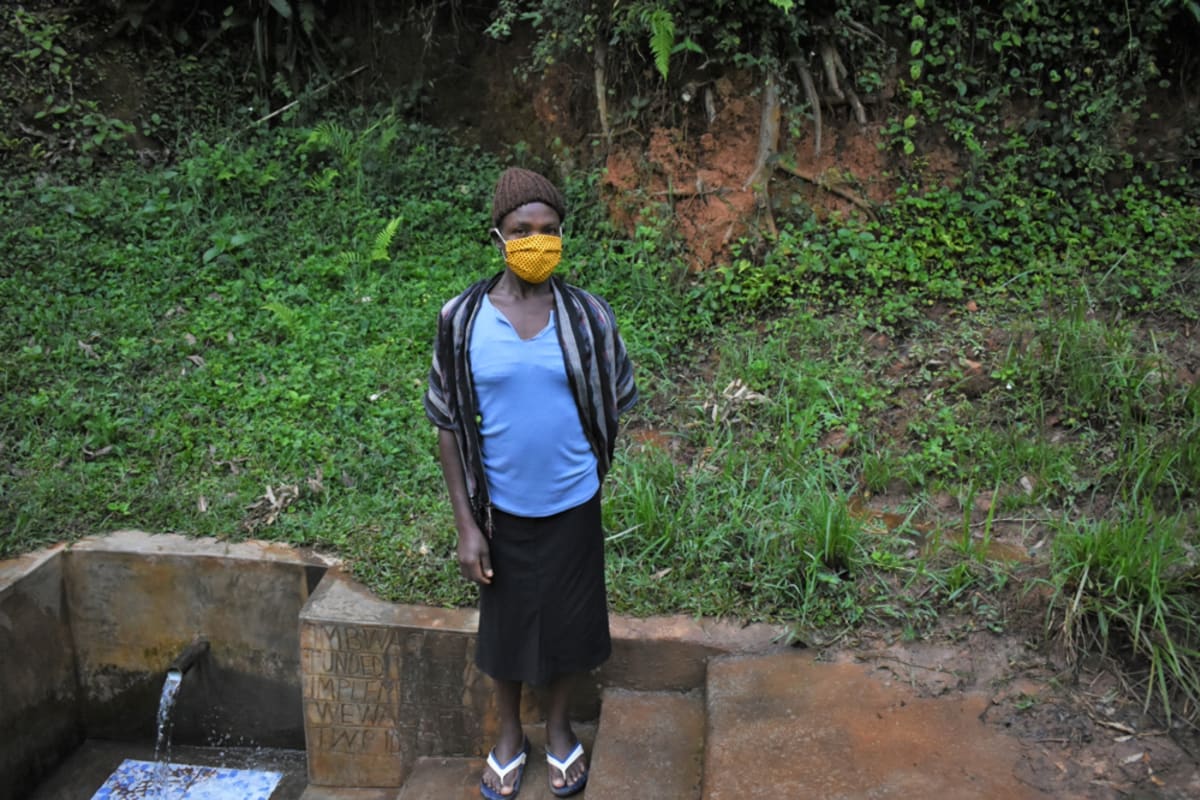May, 2020: COVID-19 Prevention Training Update at Bumira Community, Imbwaga Spring
Our teams are working on the frontlines of the COVID-19 pandemic. Join us in our fight against the virus while maintaining access to clean, reliable water.

We are carrying out awareness and prevention trainings on the virus in every community we serve. Very often, our teams are the first (and only) to bring news and information of the virus to rural communities like Bumira, Kenya.
We trained more than 37 people on the symptoms, transmission routes, and prevention of COVID-19. Before there were any reported cases in the area, we worked with trusted community leaders and the Water User Committee to gather community members for the training.

We covered essential hygiene lessons:
- Demonstrations on how to build a simple handwashing station
- Proper handwashing technique
- The importance of using soap and clean water for handwashing
- Cleaning and disinfecting commonly touched surfaces including at the water point.

We covered COVID-19-specific guidance in line with national and international standards:
- Information on the symptoms and transmission routes of COVID-19
- What social distancing is and how to practice it
- How to cough into an elbow
- Alternative ways to greet people without handshakes, fist bumps, etc.
- How to make and properly wear a facemask.
During training, we installed a new handwashing station with soap near the community’s water point, along with a sign with reminders of what we covered.
Due to the rampant spread of misinformation about COVID-19, we also dedicated time to a question and answer session to help debunk rumors about the disease and provide extra information where needed.
We continue to stay in touch with this community as the pandemic progresses. We want to ensure their water point remains functional and their community stays informed about the virus.
Water access, sanitation, and hygiene are at the crux of disease prevention. You can directly support our work on the frontlines of COVID-19 prevention in all of the communities we serve while maintaining their access to safe, clean, and reliable water.

February, 2020: Bumira Community, Imbwaga Spring Project Complete!
Bumira Community now has access to clean water! Imbwaga Spring has been transformed into a flowing source of water thanks to your donation. We protected the spring, constructed 5 sanitation platforms for different households in the community, and we trained the community on improved sanitation and hygiene practices.

Children enjoying the fresh spring water
Breaking "The Water Curse"
Before protection, Imbwaga Spring was believed to be cursed water. During the hygiene training, 2 women with small children aged 3 -5 months attended the training but sat 100 meters away from the training venue. When the facilitator beckoned them to join the rest of the team, the 2 women shouted at the top of their voices “We cannot come here at the spring as our children will be infected!"

Foreground: Facilitator Amos leads the dental hygiene session; Background: 2 women with their children refused to come closer to the spring's shade during training due to "the water curse"
The facilitator probed them about what kind of infection and they responded that their water had been discharging a bad infection called in the local language “Muyaka”. The community members believed that since the spring was unprotected, it had always discharged bad air in the form of infections and when a baby was infected, they believed no amount of treatment could cure the infection. In most cases, the child would pass on within a few hours. The signs and symptoms included diarrhea, fever, and vomiting - some of the most common symptoms of waterborne diseases such as giardia, cholera, and typhoid, contracted not through the air but through the consumption of the water.
The curse was believed to be heightened at night, so no one would approach the spring until after sunrise, no matter the cost of waking up without water. During the construction period, our artisan would wake up early and go to the spring to do some curing of the cement before he returned to his host family to take breakfast each day. On the second day when he came back from the spring, his host inquired where he came from and he stated, "From curing the spring." The host cautioned the artisan against going to the spring early in the morning as the curse would befall the family that was hosting him. The unskilled laborers, on the other hand, who came from the community, would not come to the spring before the sun rose each day.

Community members confidently celebrate protected Imbwaga Spring, breaking "the water curse"
But on the final day that the spring was backfilled, everyone confidently came to the spring and they started celebrating while singing that the Lord had done a great thing by sending the curse away when the spring was covered, for they believed the curse had also been buried forever. The occasion was full of pomp and circumstance, including much singing and dancing.
The joy within this community was overwhelming; to them, they were celebrating freedom from diseases and from "the water curse".

Thumbs up and smiles at the spring
"Truly the protection of Imbwaga Spring is really a good omen in this community," said Karen Maruti, the lead Field Officer for this project. Community members agreed.
"To me, it's an answered prayer because women in this community feared coming down to the spring for fear of being affected by the water curse. If we had no water for making breakfast, we had to wait till the sun rose as it is believed the sun's rays kill the curse. At times when the sun did not rise, we would stay hungry," reflected a primary school student from the community, Maurine.
"Thanks for protecting our spring. I can now come down at any time without fear. Life will be sweet as I can finish my chores on time and go play with my friends or read," she said.
Spring Protection: Construction Process
Community members provided all locally available construction materials, including bricks, wheelbarrows of clean sand, stones, and fencing poles. Accommodations and meals were provided for the artisan, too.

Kids help carry bricks and sand to the construction site
Women and men lent their strength to the artisan to help him with manual labor. The spring area was excavated to create space for setting the foundation of thick plastic tarp, wire mesh, and concrete. After the base had been set, both wing walls and the headwall were set in place using brickwork. The discharge pipe was fixed low in place through the headwall to direct the water from the reservoir to the drawing area.

Bricklaying begins over the concrete foundation
As the wing walls and headwall were curing, the stairs were set and ceramic tiles were fixed directly below the discharge pipe. This protects the concrete from the erosive force of the falling water and beautifies the spring. The process of plastering the headwall and wing walls on both sides reinforces the brickwork and prevents water from the reservoir from seeping through the walls and allows pressure to build in the collection box to push water up through the discharge pipe.

Artisan sets the pipe into the headwall
The source area was then filled up with clean stones and sand and covered with a thick plastic tarp to prevent potential sources of contamination. The only challenge we experienced throughout the construction process was the seasonal rains which were frequent and heavy. On the first night when the foundation had been cast at the spring, there were heavy rains that covered the slab and the next day the community members had to drain the water away before brickwork commenced. Every day, work had to be stopped early whenever the rains came in. Our artisan and the community members persisted, however, and finally all work came to a close.

Cementing the stairs
It took about 2 weeks of patience for the concrete to dry. As soon as it was ready, people got the okay from our field officers to begin fetching clean water, as marked by the joyous handing over ceremony.

Stellah Khalawa heads for home with clean water from the spring
Sanitation Platforms
All 5 sanitation platforms have been installed. These 5 families are happy about this milestone of having a private latrine of their own and are optimistic that people will no longer leave waste outdoors. We are continuing to encourage families to finish building walls and roofs over their new latrine floors.

Proud new sanitation platform owner
New Knowledge
Stellah Khalawa, the spring's landowner and woman who would be voted as Chair of the new water user committee, was tasked with organizing the training. Stellah gave us the community’s preferred date for training, for she was very much aware of the community calendar when it comes to planting season and other big events.
14 people attended training, which was held in the shade at the spring. The participants were actively involved the whole day, asking and answering questions after every topic and participating in demonstrations whenever called upon. They also listened attentively and made notes for future reference.

A woman volunteers to demonstrate toothbrushing
We covered several topics including leadership and governance; operation and maintenance of the spring; healthcare; family planning; immunizations; and the prevention and spread of disease. We also discussed water treatment methods, personal care like handwashing, environmental hygiene, hygiene promotion, and many other things.
During the operations and maintenance session, we discussed how the spring should be managed and maintained so that it can serve the community for the longest time possible. It was in this discussion that community member Pamela Amboko was appointed by her neighbors as the Community Health Volunteer (CHV). In this role, Pamela will be in charge of the cleanliness of the spring, delegating a schedule of tasks to a rotating group of spring users. This was special because the participants gave their maximum attention to the facilitators and everyone promised to keep the spring clean which was an assurance of the sustainability of the spring.

Site management session at the spring while it was under construction
Under the topic of water handling and treatment, the facilitator described to the participants how clean water can be contaminated through the use of dirty containers when fetching water, a dirty environment at the spring, or even by putting leaves in buckets containing clean water. This session was special because one of the women said that she had a habit of putting leaves in her bucket of water so that the water could pour onto her while she carried it, but she had never thought of it as a health hazard.

"Leave the leaves out of the water!" says Trainer Karen
Now that she was enlightened she promised to stop it and also caution other people against it. At the close of this session, participants could be seen washing their water containers thoroughly before fetching water and the business of sitting on open water containers was also being shunned by everyone.
"Today I have learned so much about safe and clean water, proper sanitation, and improved hygiene practices. There will definitely be positive behavior changes which will, in turn, lead to a healthy community. Thank you for this great gift of water," said Stellah.
Thank you for making all of this possible!


 Protected Spring
Protected Spring
 Rehabilitation Project
Rehabilitation Project








































